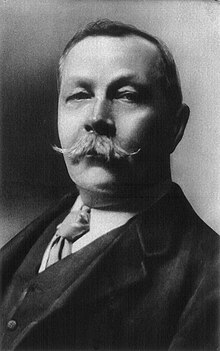About the Book: "The Final Problem" is a short story by Arthur Conan Doyle featuring his detective character Sherlock Holmes. It was first published in Strand Magazine in December 1893. It appears in book form as part of the collection The Memoirs of Sherlock Holmes. Conan Doyle later ranked "The Final Problem" fourth on his personal list of the twelve best Holmes stories.
About the Author: Arthur Ignatius Conan Doyle was born on 22 May 1859 at 11 Picardy Place, Edinburgh, Scotland. From 1876 to 1881, he studied medicine at the University of Edinburgh, including a period working in the town of Aston (now a district of Birmingham) and in Sheffield, as well as in Shropshire at Ruyton-XI-Towns. While studying, Doyle began writing short stories. His earliest extant fiction, "The Haunted Grange of Goresthorpe", was unsuccessfully submitted to Blackwood's Magazine. His first published piece "The Mystery of Sasassa Valley", a story set in South Africa, was printed in Chambers's Edinburgh Journal on 6 September 1879. On 20 September 1879, he published his first non-fiction article, "Gelsemium as a Poison" in the British Medical Journal. In 1882 he joined former classmate George Turnavine Budd as his partner at a medical practice in Plymouth, but their relationship proved difficult, and Doyle soon left to set up an independent practice. Arriving in Portsmouth in June of that year with less than £10 (£900 today) to his name, he set up a medical practice at 1 Bush Villas in Elm Grove, Southsea. The practice was initially not very successful. While waiting for patients, Doyle again began writing stories and composed his first novels, The Mystery of Cloomber, not published until 1888, and the unfinished Narrative of John Smith, which would go unpublished until 2011. He amassed a portfolio of short stories including "The Captain of the Pole-Star" and "J. Habakuk Jephson's Statement", both inspired by Doyle's time at sea, the latter of which popularized the mystery of the Mary Celeste and added fictional details such as the perfect condition of the ship (which had actually taken on water by the time it was discovered) and its boats remaining on board (the one boat was in fact missing) that have come to dominate popular accounts of the incident. Doyle struggled to find a publisher for his work. His first significant piece, A Study in Scarlet, was taken by Ward Lock Co. on 20 November 1886, giving Doyle £25 for all rights to the story. The piece appeared later that year in the Beeton's Christmas Annual and received good reviews in The Scotsman and the Glasgow Herald. The story featured the first appearance of Watson and Sherlock Holmes, partially modeled after his former university teacher Joseph Bell. Doyle wrote to him, "It is most certainly to you that I owe Sherlock Holmes ... Round the center of deduction and inference and observation which I have heard you inculcate I have tried to build up a man." Robert Louis Stevenson was able, even in faraway Samoa, to recognize the strong similarity between Joseph Bell and Sherlock Holmes: "My compliments on your very ingenious and very interesting adventures of Sherlock Holmes. ... Can this be my old friend Joe Bell?" Other authors sometimes suggest additional influences—for instance, the famous Edgar Allan Poe character C. Auguste Dupin. A sequel to A Study in Scarlet was commissioned and The Sign of the Four appeared in Lippincott's Magazine in February 1890, under agreement with the Ward Lock company. Doyle felt grievously exploited by Ward Lock as an author new to the publishing world and he left them. Short stories featuring Sherlock Holmes were published in the Strand Magazine. Doyle first began to write for the 'Strand' from his home at 2 Upper Wimpole Street, now marked by a memorial plaque. In this period, however, Holmes was not his sole subject and in 1893, he collaborated with J.M. Barrie on the libretto of Jane Annie. Doyle was found clutching his chest in the hall of Windlesham Manor, his house in Crowborough, East Sussex, on 7 July 1930. He died of a heart attack at the age of 71. His last words were directed toward his wife: "You are wonderful." At the time of his death, there was some controversy concerning his burial place, as he was avowedly not a Christian, considering himself a Spiritualist. He was first buried on 11 July 1930 in Windlesham rose garden. He was later reinterred together with his wife in Minstead churchyard in the New Forest, Hampshire. Carved wooden tablets to his memory and to the memory of his wife are held privately and are inaccessible to the public. That inscription reads, "Blade straight / Steel true / Arthur Conan Doyle / Born May 22nd 1859 / Passed On 7th July 1930." The epitaph on his gravestone in the churchyard reads, in part: "Steel true/Blade straight/Arthur Conan Doyle/Knight/Patriot, Physician, and man of letters". Undershaw, the home near Hindhead, Haslemere, south of London, that Doyle had built and lived in between October 1897 and September 1907, was a hotel and restaurant from 1924 until 2004. It was then bought by a developer and stood empty while conservationists and Doyle fans fought to preserve it. In 2012 the High Court ruled that the redevelopment permission be quashed because proper procedure had not been followed. A statue honours Doyle at Crowborough Cross in Crowborough, where he lived for 23 years. There is also a statue of Sherlock Holmes in Picardy Place, Edinburgh, close to the house where Doyle was born.
My Review: This story, set in 1891, introduces Holmes's greatest opponent, the criminal mastermind Professor James Moriarty.
Holmes arrives at Dr. John Watson's residence one evening in a somewhat agitated state and with grazed and bleeding knuckles. He has apparently escaped three murder attempts that day after a visit from Professor Moriarty, who warned Holmes to withdraw from his pursuit of justice against him to avoid any regrettable outcome. First, just as he was turning a street corner, a cab suddenly rushed towards him and Holmes just managed to leap out of the way in time. Second, while Holmes was walking along the street, a brick fell from the roof of a house, just missing the detective. He then called the police to search the whole area but could not prove that it was anything other than an accident. Finally, on his way to Watson's house, he was attacked by a thug armed with a cosh. Holmes managed to overcome his assailant and handed him to the police but admitted that there was virtually no hope of proving that the man was in the employ of the criminal mastermind.
Holmes has been tracking Moriarty and his agents for months and is on the brink of snaring them all and delivering them to the dock. Moriarty is the criminal genius behind a highly organized and extremely secret criminal force and Holmes will consider it the crowning achievement of his career if only he can defeat Moriarty. Moriarty is out to thwart Holmes's plans and is well capable of doing so, for he is, as Holmes admits, the great detective's intellectual equal.
Holmes asks Watson to come to the continent with him, giving him unusual instructions designed to hide his tracks to Victoria station. Holmes is not quite sure where they will go; this seems rather odd to Watson. Holmes, certain that he has been followed to his friend's house, then makes off by climbing over the back wall in the garden. The next day Watson follows Holmes's instructions to the letter and finds himself waiting in the reserved first class coach for his friend, but only an elderly Italian priest is there. The cleric soon makes it apparent that he is Holmes in disguise.
As the train pulls out of Victoria, Holmes spots Moriarty on the platform, apparently trying to get someone to stop the train. Holmes is forced to take action as Moriarty has obviously tracked Watson, despite extraordinary precautions. He and Watson alight at Canterbury, making a change to their planned route. As they are waiting for another train to Newhaven a special one-coach train roars through Canterbury, as Holmes suspected it would. It contains Moriarty, who has hired the train in an effort to overtake Holmes. Holmes and Watson are forced to hide behind luggage.
Having made their way to Strasbourg via Brussels, the following Monday Holmes receives a message that most of Moriarty's gang have been arrested in England and recommends Watson return there now, as the detective will likely prove to be a very dangerous companion. Watson, however, decides to stay with his friend. Moriarty himself has slipped out of the grasp of the English police and is obviously with them on the continent.
Holmes and Watson's journey takes them to Switzerland where they stay at Meiringen. From there they fatefully decide to take a walk which will include a visit to Reichenbach Falls, a local natural wonder. Once there, a boy appears and hands Watson a note, saying that there is a sick Englishwoman back at the hotel who wants an English doctor. Holmes realises at once it is a hoax although he does not say so. Watson goes to see about the patient, leaving Holmes alone.
Upon returning to the Englischer Hof, Watson finds that the innkeeper has no knowledge of any sick Englishwoman. Realizing at last that he has been deceived, he rushes back to Reichenbach Falls but finds no one there, although he does see two sets of footprints going out onto the muddy dead end path with none returning. There is also a note from Holmes, explaining that he knew the report Watson was given to be a hoax and that he is about to fight Moriarty, who has graciously given him enough time to pen this last letter. Watson sees that towards the end of the path there are signs that a violent struggle has taken place and there are no returning footprints. It is all too clear Holmes and Moriarty have both fallen to their deaths down the gorge while locked in mortal combat. Heartbroken, Dr. Watson returns to England.
I recommend this book to all readers that appreciate a well written mystery story.



No comments:
Post a Comment